In this process, liquid crystal is placed between the TFT substrate and a color filter substrate used to display the colors, and the two substrates are then laminated together. A liquid crystal dripping machine precisely and accurately controls the position and amount of the liquid crystal placed between the glass substrates. A lamination machine takes the two substrates—the TFT substrate made from a huge nine-square-meter G10 glass substrate and a G10 color filter substrate—and combines them, ensuring they are aligned against each other to within several micrometers of accuracy.
Masters of LCD Technology Achieve Consistent Manufacturing of High-Quality Large-Screen LCDs
To manufacture large-screen LCDs requires advanced technologies for intricately precise processing of massive glass substrates. This is made possible by manufacturing know-how built up over many years by LCD master craftsmen. Such sophisticated techniques allow the consistent production of high-performance, high-quality large-screen LCDs. You could say that SDP’s plants are where the dreams of LCD master craftsmen become a reality.
Sophisticated LCD Technologies and State-of-the-Art Manufacturing Equipment Lead to High Quality
The World’s Only Large-Screen LCD Plant Using G10 Glass Substrate
The cutting-edge G10 production line is a result of cutting-edge technology. To consistently manufacture LCD panels using the G10 glass substrates, each individual manufacturing process incorporates a range of unique know-how. Developed in collaboration with several world-leading production equipment manufacturers, SDP's large-scale, one-of-a-kind manufacturing equipment delivers state-of-the-art accuracy and performance levels. One example is the photolithography machine, which is about the size of a tennis court. Our master-craftsmen operate and monitor this machine with the utmost care, to manufacture next-generation products.
■Main Processes in Manufacture of Large-Screen LCD Panels

■Film Deposition Process
In this process, the entire G10 glass substrate is covered with various types of film, such as the circuitry that forms the TFT* (thin-film transistor). There are numerous, extremely large pieces of equipment that produce uniform layers across the entire glass substrate—for example, a sputtering machine that deposits a metallic film, and a CVD (chemical vapor deposition) system that deposits an insulation film and a semiconductor film using the plasma-enhanced chemical vapor deposition method.
* The TFT is formed on the glass substrate and drives the LCD.
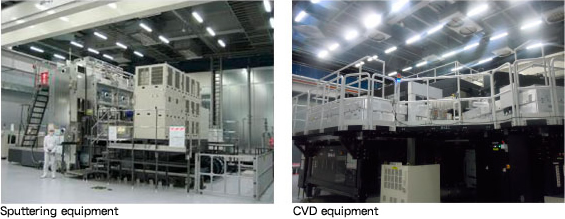
■Photolithography Process
In the design of the substrate, photolithography is used to form circuits and wiring. First, a coater system is used to apply photosensitive material—called “photoresist”—rapidly and uniformly across the entire glass substrate. Next, using a photolithography machine, the glass substrate is irradiated with ultraviolet light, transferring onto it a high-precision TFT pattern via a mask. A developing system uses developer fluid to dissolve and remove the photoresist previously applied using the photolithography machine, and only the resist that forms the TFT pattern remains.
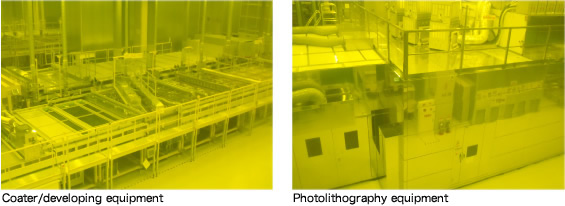
Note: The photo has a yellow tint, owing to the use of yellow lighting that does not damage the photoresist.
■Etching, Photoresist Stripping Process
In the etching process, portions not covered by resist are removed to form the transistor circuits. There are two kinds of etching machines: a dry etching machine that uses corrosive gas to decompose and remove the insulation film and semiconductor film; and a wet etching machine that uses a liquid chemical to dissolve the metal film. After etching, a resist stripping machine is used to remove the photoresist.
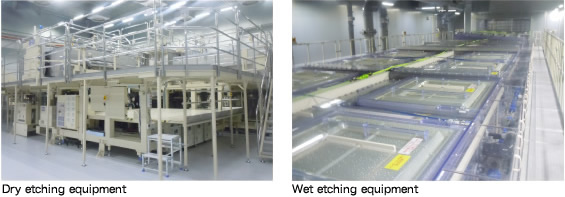
■Liquid Crystal Process
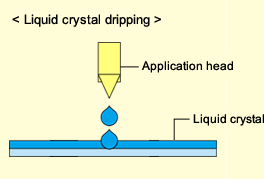
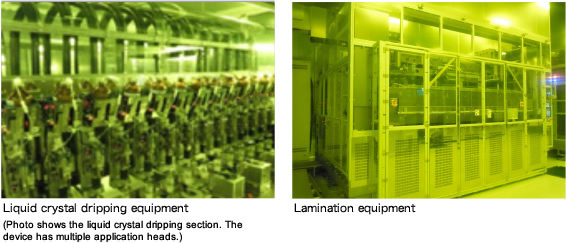
Note: The photo has a yellow tint, owing to the use of yellow lighting that does not damage the material.




